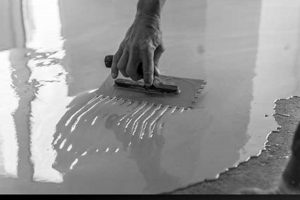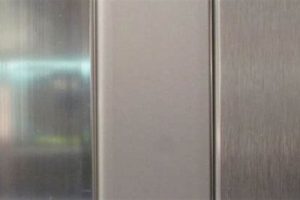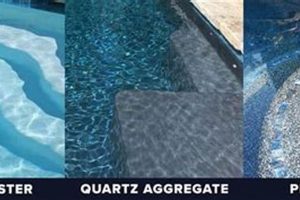Maintaining the aesthetic appeal and longevity of kitchen cabinetry often necessitates a cleaning approach that prioritizes the preservation of the existing protective layer. This involves employing specific techniques and cleaning agents formulated to lift away grime and residue without compromising the integrity of the painted, stained, or varnished surface. For example, a gentle solution of dish soap and warm water, applied with a soft cloth, can effectively remove everyday spills and splatters without damaging the finish.
The careful maintenance of cabinetry finishes is paramount to preserving both the visual appearance and the structural soundness of the units. Damage to the finish can lead to accelerated wear and tear, including discoloration, peeling, and warping of the underlying wood. Historically, harsh cleaning chemicals were frequently used, resulting in premature degradation of the cabinet’s surface. Modern cleaning practices emphasize gentle, preventative measures to extend the lifespan of the cabinetry.
The subsequent sections will detail specific cleaning solutions and application methods suitable for various cabinet finishes. Information regarding routine maintenance schedules and preventative measures designed to minimize the need for aggressive cleaning will also be presented.
Cleaning Kitchen Cabinets
The following recommendations are designed to facilitate the effective cleaning of kitchen cabinets while preserving the integrity of the existing finish. Adherence to these guidelines will help extend the lifespan and aesthetic appeal of cabinetry.
Tip 1: Initiate cleaning with a gentle approach. Employ a soft, damp cloth to remove loose dust and surface debris. Avoid abrasive materials that could scratch or dull the finish.
Tip 2: Utilize a mild cleaning solution consisting of warm water and a few drops of dish soap. This mixture is generally effective for removing everyday grime without causing damage. Test the solution in an inconspicuous area first.
Tip 3: Apply the cleaning solution with a soft cloth or sponge, working in small sections. Avoid excessive saturation, as moisture can penetrate and damage the underlying wood.
Tip 4: Rinse the cleaned areas with a separate damp cloth to remove any soap residue. Ensure thorough removal of the cleaning solution to prevent a hazy or sticky buildup.
Tip 5: Dry the cleaned surfaces immediately with a clean, dry cloth. This prevents water spots and potential damage to the finish from prolonged exposure to moisture.
Tip 6: For stubborn stains or grease buildup, consider using a specialized cabinet cleaner specifically formulated for the type of finish on the cabinets. Always follow the manufacturer’s instructions.
Tip 7: Avoid using abrasive cleaners, scouring pads, or steel wool, as these can easily scratch and damage the cabinet finish.
Tip 8: Regularly clean cabinet hardware, such as knobs and pulls, as accumulated grime can detract from the overall appearance. Use a separate cleaning solution appropriate for the hardware material.
Consistent application of these techniques will contribute to the long-term preservation of kitchen cabinet finishes, avoiding the need for costly repairs or replacements.
The subsequent section will address the specific challenges and solutions associated with different types of cabinet finishes.
1. Gentle cleaning agents
The efficacy of cleaning kitchen cabinets while preserving their existing finish is inextricably linked to the selection of appropriate cleaning agents. Harsh chemicals can compromise the protective layer, leading to discoloration, peeling, or other forms of damage. Therefore, the employment of gentle cleaning agents becomes a critical component in maintaining the integrity and aesthetic appeal of the cabinetry. For instance, a diluted solution of pH-neutral dish soap in warm water provides sufficient cleaning power for routine maintenance without posing a significant risk to the finish. This approach prioritizes the removal of surface grime and grease while minimizing the potential for chemical degradation.
The practical application of gentle cleaning agents extends beyond simple grime removal. Regular use of these solutions can prevent the buildup of stubborn stains and grease deposits, reducing the need for more aggressive cleaning methods in the future. Consider the example of painted cabinets, which are particularly susceptible to damage from harsh chemicals. Consistent cleaning with a gentle solution, followed by thorough drying, can significantly extend the lifespan of the painted surface, preventing the need for costly repainting or refinishing. The proper application, combined with soft cleaning cloths, is essential to minimize damage to the cabinet finish, ensuring a prolonged and well-maintained cabinet system.
In summary, the utilization of gentle cleaning agents is not merely a recommendation but a necessity for effectively cleaning kitchen cabinets without removing the finish. This approach safeguards the cabinet’s protective layer, prevents long-term damage, and reduces the need for aggressive cleaning interventions. While specific cleaning agents may vary depending on the cabinet finish, the underlying principle of gentleness remains paramount to maintaining the cabinetry’s beauty and longevity.
2. Soft cleaning cloths
The selection of cleaning implements directly influences the success of cleaning kitchen cabinets while preserving their finish. Abrasive materials inevitably inflict scratches, dull the surface, and compromise the protective layer, leading to long-term aesthetic degradation and potential structural damage. Consequently, the employment of soft cleaning cloths is a crucial component of any strategy designed to maintain cabinet finishes. These cloths, typically made of microfiber or cotton, offer a gentle interface between the cleaning solution and the cabinet surface, minimizing the risk of abrasion. For example, when removing grease splatters from painted cabinets, a soft microfiber cloth saturated with a mild cleaning solution effectively lifts the residue without marring the underlying paint.
The practical application of soft cloths extends beyond simply preventing scratches. These materials possess superior absorption capabilities, enabling the efficient removal of cleaning solutions and loosened grime from the cabinet surface. This is particularly important for intricately detailed cabinet doors, where excess moisture can accumulate and cause damage over time. Consider the scenario of cleaning raised-panel cabinet doors. A soft cloth, dampened rather than soaked, allows for precise application of the cleaning solution and thorough removal of residue from the recessed areas, preventing water damage and preserving the integrity of the finish. Furthermore, the use of color-coded cloths can prevent cross-contamination between different cleaning tasks, further safeguarding the cabinet’s surface.
In summary, the strategic use of soft cleaning cloths is not merely an optional step, but an essential element in cleaning kitchen cabinets without removing the finish. Their non-abrasive nature minimizes the risk of scratches, while their absorbent properties facilitate the efficient removal of cleaning solutions and grime. Integrating soft cloths into a comprehensive cleaning regimen ensures the longevity and aesthetic appeal of kitchen cabinetry, mitigating the need for costly repairs or refinishing. The selection of appropriate cleaning agents, coupled with the careful application using soft cloths, underscores a commitment to preserving the beauty and durability of kitchen cabinets.
3. Minimal water usage
The correlation between minimal water usage and preserving kitchen cabinet finishes during cleaning is significant. Excessive water can penetrate the protective layer, leading to swelling, warping, and eventual delamination of the finish from the underlying wood or substrate. The porous nature of wood, particularly in areas where the finish is compromised, allows water to be absorbed, causing irreversible structural damage. Therefore, employing cleaning techniques that minimize water exposure is crucial for maintaining the integrity of the cabinet finish. For instance, instead of directly spraying cabinets with a cleaning solution, applying a dampened cloth ensures controlled moisture application.
Practical application involves several key strategies. Utilizing a well-wrung cloth ensures that only a minimal amount of water is applied to the surface. Immediate drying with a clean, absorbent cloth is essential to remove any residual moisture. For deep cleaning, employing specialized cleaning products designed for low-moisture application can be beneficial. Consider the example of laminate cabinets, which are particularly susceptible to water damage along seams and edges. Controlled application of cleaning agents and immediate drying can prevent the laminate from peeling or bubbling. Regular cleaning with minimal water reduces the need for harsh chemicals, further preserving the finish.
In summary, minimal water usage is not merely a cleaning preference but a necessary practice for preserving kitchen cabinet finishes. Excess moisture poses a significant threat to the structural integrity and aesthetic appeal of cabinets. Implementing controlled application techniques and prompt drying methods safeguards against water damage. This approach, combined with gentle cleaning agents, contributes to the longevity and maintenance of kitchen cabinets, avoiding the need for costly repairs or replacements. The challenges associated with water damage can be effectively addressed through consistent adherence to minimal water usage principles.
4. Proper drying methods
The implementation of proper drying methods is an integral component of effective kitchen cabinet cleaning that aims to preserve the existing finish. Inadequate drying following cleaning operations allows residual moisture to penetrate the cabinet’s surface, potentially leading to damage such as swelling, warping, or the delamination of the finish. These adverse effects undermine the structural integrity and aesthetic appearance of the cabinetry. Therefore, the efficacy of cleaning efforts is contingent upon the execution of appropriate drying protocols. For instance, after wiping down cabinet doors with a damp cloth, a subsequent pass with a clean, dry microfiber cloth ensures the removal of any remaining moisture, thereby minimizing the risk of water damage.
The practical application of proper drying methods extends beyond simple moisture removal. It also involves selecting appropriate drying materials and techniques based on the type of cabinet finish. For painted cabinets, gentle patting motions with a soft cloth are preferable to aggressive rubbing, which could potentially mar the finish. For wood cabinets with a varnish or lacquer coating, ensuring adequate ventilation can facilitate the drying process and prevent the formation of water spots. Furthermore, the use of dehumidifiers in particularly humid environments can further mitigate the risk of moisture-related damage. Consider the scenario where a spill occurs on a cabinet surface. Immediate blotting with an absorbent cloth, followed by thorough drying, can prevent staining and preserve the finish’s integrity.
In summary, proper drying methods are not merely a finishing touch but a critical element in preserving kitchen cabinet finishes during cleaning. The failure to adequately dry surfaces after cleaning can negate the benefits of even the most meticulous cleaning procedures. Implementing appropriate drying techniques, tailored to the specific cabinet finish, safeguards against moisture-related damage and ensures the long-term preservation of kitchen cabinetry. The understanding and application of proper drying methods are essential for anyone seeking to maintain the appearance and structural integrity of their kitchen cabinets without removing the finish.
5. Regular maintenance schedule
A regular maintenance schedule is fundamental to the successful and sustained effort to clean kitchen cabinets without removing the finish. Consistent, proactive cleaning minimizes the accumulation of grime and grease, thereby reducing the need for aggressive cleaning methods that could damage the cabinet finish. The absence of a structured maintenance plan often leads to the buildup of stubborn residues, necessitating harsher cleaning agents and techniques that risk compromising the protective layer of the cabinetry.
- Preventing Buildup
A routine cleaning schedule, implemented weekly or bi-weekly, effectively prevents the excessive buildup of grease, food splatters, and dust on cabinet surfaces. This proactive approach limits the adherence of these substances, making subsequent cleaning operations less intensive and reducing the reliance on abrasive cleaning tools or harsh chemical solutions that could harm the finish. For instance, wiping down cabinets weekly with a mild detergent solution can prevent grease from hardening and becoming difficult to remove, thereby safeguarding the finish.
- Extending Finish Lifespan
Consistent and gentle cleaning practices, as part of a regular maintenance schedule, contribute to the extended lifespan of the cabinet finish. By preventing the accumulation of damaging substances, such as acidic food splatters, a routine cleaning regimen minimizes the potential for corrosion, discoloration, and premature wear of the finish. Consider the example of wooden cabinets with a varnish coating; regular cleaning with a soft cloth and gentle cleaner preserves the integrity of the varnish, preventing it from cracking or peeling over time.
- Early Stain Detection and Removal
A structured cleaning schedule facilitates the early detection and removal of stains before they become deeply embedded in the cabinet finish. Promptly addressing spills and splatters prevents the staining agents from penetrating the protective layer, making them easier to remove with gentle cleaning methods that do not compromise the finish. For example, immediately wiping away coffee or juice spills from a painted cabinet surface minimizes the risk of permanent staining, preserving the appearance of the finish.
- Minimizing Chemical Exposure
The establishment of a consistent cleaning routine reduces the need for strong chemical cleaners that can degrade or strip the cabinet finish. By implementing a regular cleaning regimen, cabinets can be maintained with mild, pH-neutral cleaning solutions that effectively remove everyday grime without posing a significant risk to the finish. For instance, wiping down cabinets with a solution of dish soap and water can be sufficient for routine maintenance, minimizing exposure to harsh chemicals that could damage the protective layer.
In conclusion, a regular maintenance schedule is not merely a supplementary activity but an essential element in the successful endeavor to clean kitchen cabinets without removing the finish. Consistent, proactive cleaning prevents buildup, extends finish lifespan, facilitates early stain removal, and minimizes chemical exposure, all contributing to the long-term preservation of the cabinetry’s appearance and structural integrity. The implementation of such a schedule reduces the need for aggressive cleaning interventions, safeguarding the protective layer and maintaining the cabinets’ aesthetic appeal for years to come.
6. Avoiding harsh chemicals
The preservation of kitchen cabinet finishes is directly contingent upon avoiding harsh chemicals during the cleaning process. Abrasive or highly alkaline/acidic substances can compromise the integrity of the protective layer applied to cabinetry, leading to discoloration, etching, peeling, or complete removal of the finish. Consequently, successful implementation of techniques to clean kitchen cabinets without damaging the finish necessitates the strict avoidance of these detrimental chemical agents. For instance, cleaners containing bleach, ammonia, or strong solvents can dissolve the varnish or paint, leaving the underlying material exposed and vulnerable to damage. The cause-and-effect relationship is clear: exposure to harsh chemicals results in finish degradation, rendering the cleaning effort counterproductive.
The significance of avoiding harsh chemicals extends beyond the immediate aesthetic impact. Damage to the finish can compromise the cabinet’s ability to resist moisture, leading to swelling, warping, and potential mold growth. This, in turn, can necessitate costly repairs or replacements. As a practical example, consider the use of a citrus-based cleaner on lacquered cabinets. While seemingly innocuous, the acidity can gradually dull the lacquer, making it more susceptible to scratching and staining. Instead, mild, pH-neutral cleaning solutions, such as diluted dish soap, effectively remove grime without posing a risk to the finish. The appropriate selection of cleaning agents is paramount to preventing long-term damage and preserving the functional and aesthetic value of kitchen cabinets.
In summary, the deliberate avoidance of harsh chemicals is not merely a precautionary measure but a fundamental requirement for cleaning kitchen cabinets without removing the finish. The detrimental effects of these substances on the cabinet’s protective layer can lead to irreversible damage and necessitate costly interventions. Adopting gentle, pH-neutral cleaning solutions and techniques is crucial for maintaining the longevity and aesthetic appeal of kitchen cabinetry. The practical significance of this understanding lies in the ability to preserve the value and functionality of kitchen cabinets, avoiding unnecessary expenses and ensuring a well-maintained and visually appealing kitchen environment. The long-term benefits associated with avoiding harsh chemicals far outweigh the perceived convenience of using more aggressive cleaning agents.
7. Targeted stain removal
Targeted stain removal is a critical aspect of maintaining kitchen cabinets without compromising their existing finish. It represents a focused approach to addressing specific blemishes while minimizing overall surface disruption.
- Identification of Stain Type
Accurate identification of the stain’s origin (e.g., grease, ink, food) dictates the appropriate cleaning agent. Applying an incorrect cleaner can exacerbate the problem or damage the finish. For example, an oil-based stain necessitates a different approach than a water-based one. Misidentifying the stain could lead to the application of a solvent that strips the cabinet’s protective layer.
- Localized Application
Targeted stain removal emphasizes applying the cleaning solution solely to the affected area. This minimizes contact with the surrounding finish, reducing the risk of unintended discoloration or damage. Using a cotton swab or a small, precise applicator allows for controlled cleaning, avoiding unnecessary exposure of the cabinet’s surface to chemicals. This method contrasts with broad application, which can lead to uneven cleaning and potential harm to the finish.
- Gentle Action and Patience
Effective stain removal often requires gentle, repetitive action rather than aggressive scrubbing. Patience is essential to allow the cleaning agent to break down the stain without resorting to abrasive techniques. Excessive force can scratch or dull the finish, especially on delicate materials. Allowing the cleaning solution to dwell on the stain for a short period before gently blotting it away can be more effective than forceful scrubbing.
- Post-Treatment Care
After stain removal, it is crucial to thoroughly rinse the area with a clean, damp cloth and dry it promptly. This removes any residual cleaning agent that could continue to affect the finish over time. Applying a protective polish or wax, if appropriate for the cabinet’s finish, can help restore and protect the cleaned area. Neglecting post-treatment care can leave the cabinet susceptible to future staining or damage.
The techniques associated with targeted stain removal directly support the goal of cleaning kitchen cabinets without removing the finish. They minimize the risk of damage by focusing cleaning efforts precisely where needed, employing appropriate agents, and exercising caution in application. This approach preserves the integrity and aesthetic appeal of kitchen cabinetry, avoiding the need for extensive refinishing or replacement.
Frequently Asked Questions
The following questions address common concerns regarding the proper methods for cleaning kitchen cabinets while preserving the existing finish. The information provided aims to clarify best practices and mitigate potential risks associated with improper cleaning techniques.
Question 1: What cleaning solutions are safest for cabinets with a painted finish?
The safest cleaning solutions typically involve a diluted mixture of mild dish soap and warm water. The pH neutrality of dish soap minimizes the risk of damaging the paint. It is advisable to test the solution on an inconspicuous area before applying it to the entire surface. Commercial cleaners specifically formulated for painted surfaces also represent a viable option, provided that they are used in accordance with the manufacturer’s instructions.
Question 2: How can grease buildup be effectively removed without damaging the cabinet finish?
Grease buildup often necessitates a slightly more aggressive cleaning approach. A degreasing solution specifically designed for kitchen use is recommended. This solution should be applied sparingly, allowing it to dwell on the surface for a brief period before wiping it away with a soft cloth. Excessive scrubbing should be avoided, as it can scratch the finish. Baking soda paste can also be effective for removing grease; however, it should be used with caution and applied gently.
Question 3: What type of cloth is recommended for cleaning kitchen cabinets?
Microfiber cloths are generally considered the optimal choice for cleaning kitchen cabinets. Their soft texture minimizes the risk of scratching the finish, while their absorbent properties effectively remove dirt and cleaning solutions. Avoid using abrasive cloths or scouring pads, as these can cause irreversible damage.
Question 4: How frequently should kitchen cabinets be cleaned to prevent damage?
The frequency of cleaning depends on usage patterns and environmental factors. However, a general guideline involves wiping down the cabinets weekly to remove surface dust and grime. More thorough cleaning should be conducted monthly or as needed to address specific spills or stains. Consistent maintenance is key to preventing the buildup of stubborn residues.
Question 5: What measures should be taken to protect the cabinet finish after cleaning?
After cleaning, ensuring that the cabinets are thoroughly dried is crucial. Additionally, applying a specialized cabinet polish or wax can provide an extra layer of protection against moisture and future stains. It is essential to select a product that is compatible with the specific type of cabinet finish. The application of such a product should adhere to the manufacturers directions.
Question 6: Can steam cleaners be safely used on kitchen cabinets?
The use of steam cleaners on kitchen cabinets is generally not recommended. The high heat and moisture levels can potentially damage the finish and cause warping or swelling of the wood. Alternative cleaning methods, such as those described above, are considered safer and more effective for maintaining cabinet finishes.
Adherence to these recommendations can significantly extend the lifespan and aesthetic appeal of kitchen cabinetry. The consistent application of gentle cleaning practices, coupled with the avoidance of harsh chemicals and abrasive materials, ensures the long-term preservation of the cabinet finish.
The subsequent section will provide detailed instructions on specific techniques for addressing various types of cabinet stains and residues.
Concluding Remarks
The preceding discussion has meticulously examined the methodologies and best practices associated with how to clean kitchen cabinets without removing finish. Emphasis has been placed on the importance of gentle cleaning agents, soft cleaning cloths, minimal water usage, proper drying methods, a regular maintenance schedule, the avoidance of harsh chemicals, and targeted stain removal. Adherence to these guidelines is paramount to preserving the integrity and aesthetic appeal of cabinetry. The systematic application of these techniques minimizes the risk of damage and extends the lifespan of the protective layer, preventing costly repairs or replacements.
The implementation of these strategies represents a commitment to responsible and effective kitchen maintenance. Protecting the investment in kitchen cabinetry ensures long-term functionality and visual appeal. The continued vigilance in adhering to these principles will contribute to a lasting and aesthetically pleasing kitchen environment.







